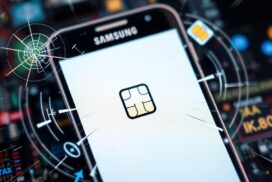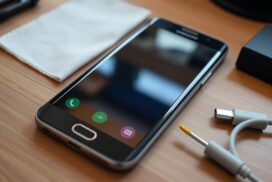Solutions for Samsung Galaxy S21+ Ghost Touch Issue
If you’re experiencing ghost touch issues on your Samsung Galaxy S21+, you’re not alone. Many users have reported this problem, but the good news is that there are several solutions you can try to resolve it. In this article, we’ll explore some troubleshooting steps that can help you get rid of the ghost touch problem on your Samsung Galaxy S21+.
Ghost touch refers to the phenomenon where the touchscreen behaves erratically, registering touches and swipes that you didn’t make. This can be frustrating and can interfere with your device’s usability. However, before you panic, there are some simple steps you can take to try and fix the issue.
First, let’s start with the basics. Cleaning the screen of your Samsung Galaxy S21+ might seem like a simple solution, but it can actually work wonders. Dirt, dust, or moisture on the screen can sometimes cause ghost touch problems. Use a soft, lint-free cloth and gently wipe the screen in a circular motion to remove any smudges or fingerprints. This simple step can often resolve the issue.
If cleaning the screen doesn’t solve the problem, the next step is to remove any screen protectors or cases that you might have on your device. Sometimes, these accessories can interfere with the touch sensitivity of the screen and cause ghost touch issues. Try removing them temporarily and check if the problem persists. If it does, you can always put them back on.
If removing screen protectors or cases doesn’t do the trick, the next troubleshooting step is to restart your device. Often, a simple restart can fix minor software glitches that may be causing the ghost touch problem. Press and hold the power button, then select the restart option when the power menu appears. Once your device restarts, check if the issue is resolved.
Another important step is to keep your Samsung Galaxy S21+ software up to date. Software updates often include bug fixes and improvements that can address touchscreen issues, including ghost touch problems. Go to Settings, navigate to Software Update, and check for any available updates. If there are updates, download and install them to ensure you have the latest software version.
If none of these steps work, it may be time to consider performing a factory reset on your device. Keep in mind that a factory reset will erase all data on your Samsung Galaxy S21+, so make sure to back up your important files before proceeding. To perform a factory reset, go to Settings, search for “Factory Reset” or “Backup & Reset,” and follow the instructions. This step should only be taken as a last resort.
If the ghost touch problem persists even after trying all these solutions, it’s possible that there may be a hardware issue with your device. In that case, it’s best to contact Samsung customer support or visit a professional technician for further assistance.
Remember, troubleshooting the ghost touch issue on your Samsung Galaxy S21+ can be a process of trial and error. It’s important to be patient and try these solutions one by one to see which one works for you. Hopefully, by following these steps, you’ll be able to resolve the ghost touch problem and enjoy a smooth touchscreen experience on your Samsung Galaxy S21+.
Cleaning the Screen
One possible cause of ghost touch issues on the Samsung Galaxy S21+ is the presence of dirt, dust, or moisture on the screen. These elements can interfere with the device’s touch sensitivity, leading to ghost touch problems. Fortunately, cleaning the screen properly can sometimes resolve this issue.
To clean the screen effectively, follow these steps:
- Power off your Samsung Galaxy S21+ and unplug it from any power source.
- Use a soft, lint-free cloth (preferably microfiber) to wipe the screen gently. Avoid using abrasive materials or cleaning solutions as they may damage the screen.
- Wipe the screen in a circular motion, ensuring that you cover the entire surface. Pay special attention to areas that appear smudged or have visible fingerprints.
- Repeat the circular wiping motion until the screen appears clean and free from any marks or residues.
By cleaning the screen thoroughly, you can eliminate any dirt, dust, or moisture that may be causing the ghost touch issue. This simple step can potentially restore the normal touch functionality of your Samsung Galaxy S21+.
Precautions:
When cleaning the screen, remember to:
- Power off your device before cleaning to prevent accidental touches.
- Use a soft, lint-free cloth to avoid scratches or damage to the screen.
- Avoid using excessive force or applying liquids directly to the screen.
Following these precautions will help ensure that you clean the screen safely and effectively, without causing any harm to your Samsung Galaxy S21+.
Removing Screen Protectors or Cases
Screen protectors or cases can sometimes interfere with the touch sensitivity of the Samsung Galaxy S21+. If you’re experiencing ghost touch issues on your device, one of the troubleshooting steps you can take is to remove the screen protector or case temporarily to check if the problem persists.
Removing the screen protector or case eliminates the possibility of any interference that might be causing the ghost touch issue. If after removing them, the problem is resolved and your device functions normally, it indicates that the screen protector or case was the culprit.
If removing the screen protector or case resolves the ghost touch issue, consider replacing it with a different screen protector or case that does not affect the touch sensitivity of your Samsung Galaxy S21+. This ensures that your device remains protected while maintaining optimal touch performance.
In some cases, the fit or material quality of the screen protector or case can cause unintended touch responses, resulting in ghost touch issues. By replacing them with a different option that is compatible with your device, you can enjoy the full touch functionality of your Samsung Galaxy S21+ without any ghost touch problems.
Restarting the Device
A simple restart can often fix minor software glitches that may be causing the ghost touch problem. Press and hold the power button until the power menu appears, then select the restart option. Once your device restarts, check if the ghost touch issue is resolved.
Restarting the device is a quick and easy troubleshooting step that can help resolve the ghost touch problem on your Samsung Galaxy S21+. It is an effective way to refresh the system and clear any temporary software issues that may be interfering with the touch screen.
To restart your Samsung Galaxy S21+, follow these steps:
- Press and hold the power button on the side or top of your device.
- A power menu will appear on the screen.
- Select the restart option. It may be labeled as “Restart” or represented by a circular arrow icon.
- Your device will turn off and then automatically restart.
- Once your device is back on, check if the ghost touch issue is resolved.
If the ghost touch problem persists after restarting your device, you may need to try other solutions to troubleshoot the issue.
Remember to regularly restart your Samsung Galaxy S21+ to ensure optimal performance and prevent any software-related problems. This simple step can help refresh the system and clear any temporary glitches that may arise.
| Pros | Cons |
|---|---|
| Quick and easy solution | May not resolve hardware issues |
| Refreshes the system and clears temporary software glitches | Requires manual intervention |
| Prevents other potential software-related problems |
Updating the Software
Keeping your Samsung Galaxy S21+ software up to date is crucial for maintaining optimal performance and resolving touchscreen issues, including the ghost touch problem. By regularly updating the software, you can benefit from bug fixes, security patches, and improvements that Samsung releases to enhance the user experience.
To update the software on your Samsung Galaxy S21+, follow these steps:
- Go to Settings.
- Navigate to Software Update.
- Check for any available updates.
- If updates are available, download and install them.
Software updates provide essential patches and optimizations to fix known issues, including ghost touch problems. By ensuring your device is running the latest software version, you can significantly reduce the likelihood of experiencing touchscreen-related issues.
Remember to connect your device to a stable Wi-Fi network and ensure it has sufficient battery power before initiating the software update process. Additionally, it’s a good practice to back up your important data before performing any updates to safeguard against potential data loss.
By incorporating regular software updates into your Samsung Galaxy S21+ maintenance routine, you can stay ahead of potential touchscreen issues and ensure a smooth and responsive user experience.
Performing a Factory Reset
If the ghost touch issue on your Samsung Galaxy S21+ persists after trying the previous solutions, you may need to consider performing a factory reset. It is important to note that a factory reset will erase all data on your device, so make sure to back up your important data beforehand.
To perform a factory reset, navigate to the Settings menu on your Samsung Galaxy S21+. Look for the option “Factory Reset” or “Backup & Reset” and follow the instructions provided. The exact location of this option may vary based on your device’s software version.
Once you initiate the factory reset process, your Samsung Galaxy S21+ will be restored to its original factory settings. This can often resolve persistent software issues, including the ghost touch problem. However, it is essential to remember that a factory reset should be considered as a last resort after trying other troubleshooting steps.
If the factory reset fails to resolve the ghost touch issue, it is possible that the problem may be related to a hardware malfunction. In such cases, it is advisable to seek further assistance from Samsung customer support or a professional technician who can provide a comprehensive diagnosis and appropriate repair solutions.
FAQ
How can I resolve ghost touch issues on my Samsung Galaxy S21+?
There are several troubleshooting steps you can take to resolve ghost touch issues on your Samsung Galaxy S21+. These include cleaning the screen, removing screen protectors or cases, restarting the device, updating the software, calibrating the touch screen, and performing a factory reset. If none of these steps work, it may be a hardware problem and you should contact Samsung customer support or a professional technician for further assistance.
How can I clean the screen of my Samsung Galaxy S21+?
To clean the screen of your Samsung Galaxy S21+, use a soft, lint-free cloth and wipe it in a circular motion. Make sure there are no smudges or fingerprints on the screen. Cleaning the screen can sometimes resolve ghost touch problems.
Can screen protectors or cases cause ghost touch issues on my Samsung Galaxy S21+?
Yes, screen protectors or cases can sometimes interfere with the touch sensitivity of your Samsung Galaxy S21+. Try removing the screen protector or case temporarily and check if the ghost touch issue persists. If removing them resolves the problem, consider replacing the screen protector or case with a different one.
How can I restart my Samsung Galaxy S21+?
To restart your Samsung Galaxy S21+, press and hold the power button until the power menu appears, then select the restart option. Once your device restarts, check if the ghost touch issue is resolved.
Why is it important to update the software on my Samsung Galaxy S21+?
Keeping your Samsung Galaxy S21+ software up to date is important for optimal performance. Software updates often include bug fixes and improvements that can address touchscreen issues, including ghost touch problems. To check for updates, go to Settings, navigate to Software Update, and download and install any available updates.
How can I perform a factory reset on my Samsung Galaxy S21+?
If none of the previous steps resolve the ghost touch issue on your Samsung Galaxy S21+, you can consider performing a factory reset. Before doing this, make sure to back up your important data as a factory reset will erase all data on your device. Go to Settings, search for “Factory Reset” or “Backup & Reset,” and follow the instructions to perform a factory reset. If the issue persists, it may indicate a hardware problem that requires further assistance from Samsung customer support or a professional technician.












